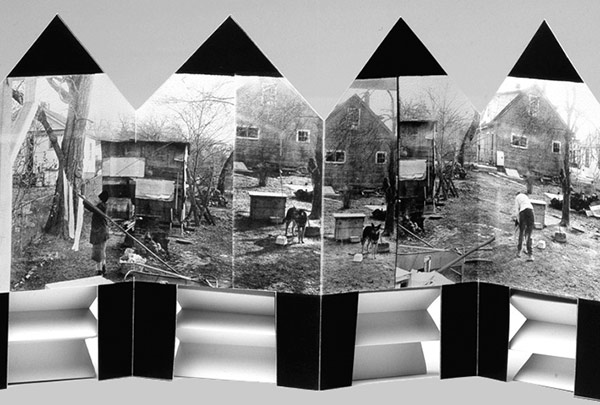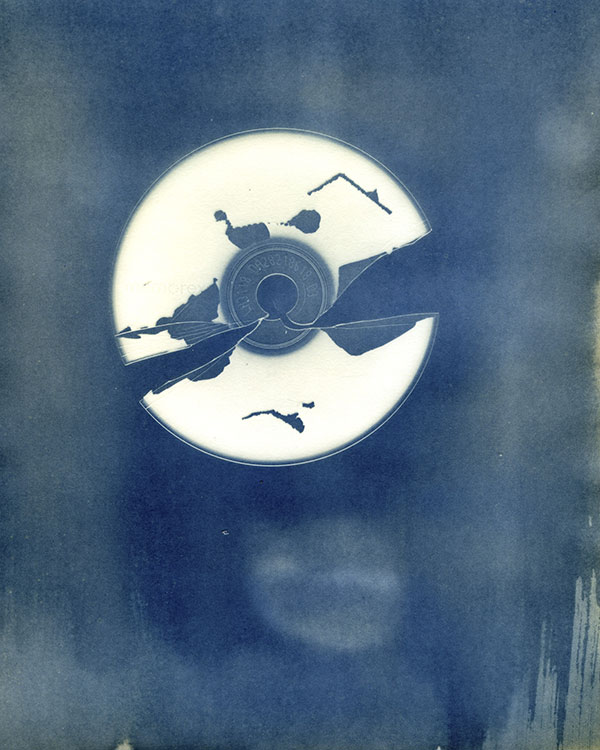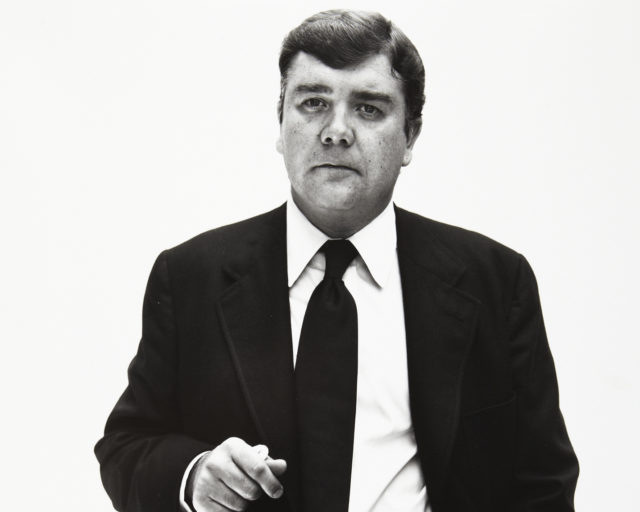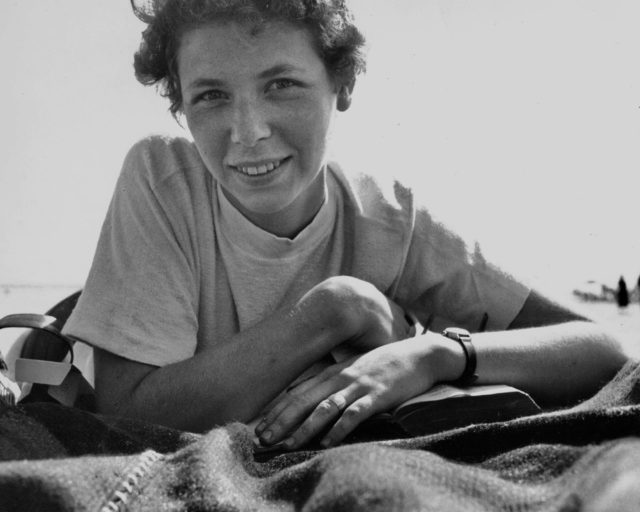First Look: photo+craft
An upcoming festival in Asheville, North Carolina, investigates the intersection of photography and craft.

Clarissa Sligh, detail from artist book What’s Happening with Momma? (Outside), 1988. Courtesy the artist
The overlaps between craft and photography have long been a matter of debate, provocation, wonder, and perplexity. The two fields and their places of intersection will be considered later this month at photo+craft, a four-day gathering in Asheville, North Carolina.
Located in the state’s western mountains, Asheville has a dynamic history in both disciplines—most notably, perhaps, as the city nearest to Black Mountain College, where original minds and ideas percolated from 1933 to 1957. At Black Mountain, particularly under the demanding eye of Josef Albers (who headed the school’s painting program for more than a decade), the distinction between craft and fine art was more or less moot: what was being taught were fundamental processes of creative thinking—channeled through media that ranged from weaving to pottery to farming to writing to mathematics to dance to sculpture, painting, and photography. (Among the school’s photography faculty at various points were Harry Callahan, Aaron Siskind, Arthur Siegel, and Beaumont Newhall.)

Alejandro Cartagena, from the series Suburbia Mexicana, 2006–09. Courtesy the artist
Asheville is home today to the Black Mountain College Museum + Arts Center, devoted to the school’s legacy—both its literal archive and its spirit. The city is also a hub of crafts institutions: the Center for Craft, Creativity and Design is here, and nearby are the Penland School of Crafts and John C. Campbell Folk School (the latter lovingly documented by photographer Doris Ulmann in the 1930s). The surrounding hills boast a rich and immeasurably deep history of individual makers and a tradition of artistic community that continues today in Asheville’s many galleries and studios.
At photo+craft, the intersections between the two disciplines will be investigated in exhibitions, workshops, and panel discussions taking place throughout the city. Two keynote speakers will anchor the festival, each an authority in one of the fields under consideration. Igniting the conversation about craft is Namita Gupta Wiggers, curator, teacher, and cofounder of the Critical Craft Forum, a web-based matrix for dialogue and resources on craft. Photography’s rapidly changing forms and roles will be addressed by Fred Ritchin, dean of education at New York’s International Center of Photography, whose publications include In Our Own Image: The Coming Revolution in Photography (first published in 1990, with revised editions in 1999 and 2010) and After Photography (2008). Ritchin’s Bending the Frame, which addresses, among other things, photography’s evolving role as a tool of advocacy and progress, was published by Aperture in 2013—his talk at photo+craft shares its title.

Elijah Gowin, Cd Relic. Courtesy the artist
The evolving understanding of digital approaches is of course a central topic at photo+craft. Among the weekend’s panel discussions is “Ghosts in the Machine: Finding Craft in the Digital,” at Asheville’s Altamont Theatre, featuring three artists whose practices challenge boundaries among media and among means of representation. James Huckenpahler creates images, books, and “virtual sculptures” on a laptop computer; Vesna Pavlović plays with perception, using, in her words, “analog photographic technology . . . in a contemporary digital mode”; and Elijah Gowin freely combines old photographic tools with new—from paper negatives to scanners—to achieve a unique and palpably handmade feel in his images. Also at the Altamont, filmmaker Harvey Wang will screen his 2014 documentary From Darkroom to Daylight: a look at the transition from film to digital photography as seen through the eyes of more than twenty eminent photographers.
In his book Bending the Frame, Ritchin insists that photography can be proactive instead of reactive, offering solutions to social conflicts rather than simply documenting them. Can the same be said of craft? The question will be considered from multiple angles this weekend, including at “Making and Meaning: Photobooks and the Social Fabric,” a discussion between Clarissa Sligh and Alejandro Cartagena, moderated by Eric Baden (photographer, educator, and photo+craft’s project director). Sligh’s long career is marked by candid engagements with social issues; her many photo-based artist’s books have tackled such fraught questions as white hegemony (e.g. in Reading Dick and Jane with Me, 1989; and It Wasn’t Little Rock, 2004) and the complexities of sexual identity (in Wrongly Bodied, 2009). Cartagena frequently turns his lens to the life and people of Monterrey, Mexico, creating images of disquieting stillness, at odds with the rampant violence of this northern region of the country. The photobook is a vital space of dissemination for both artists.

Steve Mann, The Boneman, New Orleans, Louisiana, 2007. Courtesy the artist
Related exhibitions will be presented throughout Asheville, including photographer Steve Mann’s Orthogonal Convergence at Pink Dog Creative, and the group show Authentic Constructions at the Henco Gallery, featuring the work of Janelle Young, Christina Z. Anderson, Constance Thalken, and artist duo Lindsay Lochman and Barbara Ciurej. Ancillary shows will be held at the Asheville Art Museum, the Center for Craft, Creativity and Design, Penland, and other venues around Asheville. In addition, a workshop titled “Cameraless Photography: Silver Figurative Rendering Salon” will be led by Robert Asman; and renowned photo-printer Rocky Kenworthy (who has printed for such luminaries as Annie Leibovitz, Don McCullin, Sebastião Salgado, and many others) will offer a tour of his Dot Editions studio.
Photo+craft winds up on Sunday, April 3, with “Building a Collection,” a talk with Asheville-based collectors Hedy Fischer, Randy Shull, and David Raymond. A portion of Raymond’s vast photography trove was recently acquired by the Cleveland Museum of Art and featured in the museum’s 2014–15 exhibition Forbidden Games: Surrealist and Modernist Photography, The David Raymond Collection. Undoubtedly under discussion here will be the weight of photography and craft’s existential (and monetary) value in relation to Art with a capital A. Or could it be that now, in 2016, that matter no longer has meaning? Just as the frontiers seem to be rapidly dissolving between creative fields, so they are, perhaps, between Art and Craft, between Art and Photography.
Diana C. Stoll is a writer and editor based in North Carolina. She is the coauthor, with Lin Arison, of The Desert and the Cities Sing, forthcoming from Chronicle Books in fall 2016.
photo+craft, sponsored by Warren Wilson College, will take place at venues throughout Asheville, North Carolina, March 31–April 3.

























